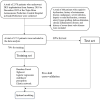Machine Learning-Based Prediction of In-Stent Restenosis Risk Using Systemic Inflammation Aggregation Index Following Coronary Stent Placement
- PMID: 38989249
- PMCID: PMC11235080
- DOI: 10.2147/RMHP.S468235
Machine Learning-Based Prediction of In-Stent Restenosis Risk Using Systemic Inflammation Aggregation Index Following Coronary Stent Placement
Abstract
Introduction: Coronary artery disease (CAD) remains a significant global health challenge, with percutaneous coronary intervention (PCI) being a primary revascularization method. In-stent restenosis (ISR) post-PCI, although reduced, continues to impact patient outcomes. Inflammation and platelet activation play key roles in ISR development, emphasizing the need for accurate risk assessment tools. The systemic inflammation aggregation index (AISI) has shown promise in predicting adverse outcomes in various conditions but has not been studied in relation to ISR.
Methods: A retrospective observational study included 1712 patients post-drug-eluting stent (DES) implantation. Data collected encompassed demographics, medical history, medication use, laboratory parameters, and angiographic details. AISI, calculated from specific blood cell counts, was evaluated alongside other variables using machine learning models, including random forest, Xgboost, elastic networks, logistic regression, and multilayer perceptron. The optimal model was selected based on performance metrics and further interpreted using variable importance analysis and the SHAP method.
Results: Our study revealed that ISR occurred in 25.8% of patients, with a range of demographic and clinical factors influencing the risk of its development. The random forest model emerged as the most adept in predicting ISR, and AISI featured prominently among the top variables affecting ISR prediction. Notably, higher AISI values were positively correlated with an elevated probability of ISR occurrence. Comparative evaluation and visual analysis of model performance, the random forest model demonstrates high reliability in predicting ISR, with specific metrics including an AUC of 0.9569, accuracy of 0.911, sensitivity of 0.855, PPV of 0.81, and NPV of 0.948.
Conclusion: AISI demonstrated itself as a significant independent risk factor for ISR following DES implantation, with an escalation in AISI levels indicating a heightened risk of ISR occurrence.
Keywords: In-stent restenosis; Systemic inflammation aggregation index; coronary artery disease; machine learning models; percutaneous coronary intervention.
© 2024 Hou et al.
Conflict of interest statement
The authors report no conflicts of interest in this work.
Figures
Similar articles
-
Systemic coagulation-inflammation index in the prediction of ISR in patients undergoing drug-eluting stents implant: A retrospective study based on multiple machine learning methods.Int J Cardiol. 2025 Jul 1;430:133215. doi: 10.1016/j.ijcard.2025.133215. Epub 2025 Mar 31. Int J Cardiol. 2025. PMID: 40174867
-
Using XGBoost for Predicting In-Stent Restenosis Post-DES Implantation: Role of Lymphocyte-to-Monocyte Ratio and Residual Cholesterol.Int J Gen Med. 2024 Aug 9;17:3443-3452. doi: 10.2147/IJGM.S477053. eCollection 2024. Int J Gen Med. 2024. PMID: 39139709 Free PMC article.
-
Risk factors for revascularization and in-stent restenosis in patients with triple-vessel disease after second-generation drug-eluting stent implantation: a retrospective analysis.BMC Cardiovasc Disord. 2021 Sep 17;21(1):446. doi: 10.1186/s12872-021-02259-0. BMC Cardiovasc Disord. 2021. PMID: 34535088 Free PMC article.
-
Blood Cell Parameters and Predicting Coronary In-Stent Restenosis.Angiology. 2019 Sep;70(8):711-718. doi: 10.1177/0003319719830495. Epub 2019 Feb 17. Angiology. 2019. PMID: 30773906 Review.
-
Risk prediction model for in-stent restenosis following PCI: a systematic review.Front Cardiovasc Med. 2024 Aug 29;11:1445076. doi: 10.3389/fcvm.2024.1445076. eCollection 2024. Front Cardiovasc Med. 2024. PMID: 39267809 Free PMC article.
Cited by
-
Association Between the Aggregate Index of Systemic Inflammation and Slow Coronary Flow Phenomenon in Patients with Ischemia and No Obstructive Coronary Arteries.Int J Gen Med. 2025 Mar 12;18:1431-1438. doi: 10.2147/IJGM.S515822. eCollection 2025. Int J Gen Med. 2025. PMID: 40092457 Free PMC article.
-
Prediction Model for in-Stent Restenosis Post-PCI Based on Boruta Algorithm and Deep Learning: The Role of Blood Cholesterol and Lymphocyte Ratio.J Multidiscip Healthc. 2024 Oct 10;17:4731-4739. doi: 10.2147/JMDH.S487511. eCollection 2024. J Multidiscip Healthc. 2024. PMID: 39403292 Free PMC article.
-
Hydrogel-based cardiac patches for myocardial infarction therapy: Recent advances and challenges.Mater Today Bio. 2024 Nov 7;29:101331. doi: 10.1016/j.mtbio.2024.101331. eCollection 2024 Dec. Mater Today Bio. 2024. PMID: 39619639 Free PMC article. Review.
-
Association between monocyte-to-lymphocyte ratio and cardiovascular diseases: insights from NHANES data.Diabetol Metab Syndr. 2025 Mar 24;17(1):98. doi: 10.1186/s13098-025-01640-9. Diabetol Metab Syndr. 2025. PMID: 40128894 Free PMC article.
-
Effect of inflammatory factors on myocardial infarction.BMC Cardiovasc Disord. 2024 Oct 7;24(1):538. doi: 10.1186/s12872-024-04122-4. BMC Cardiovasc Disord. 2024. PMID: 39375629 Free PMC article.
References
LinkOut - more resources
Full Text Sources
Miscellaneous






